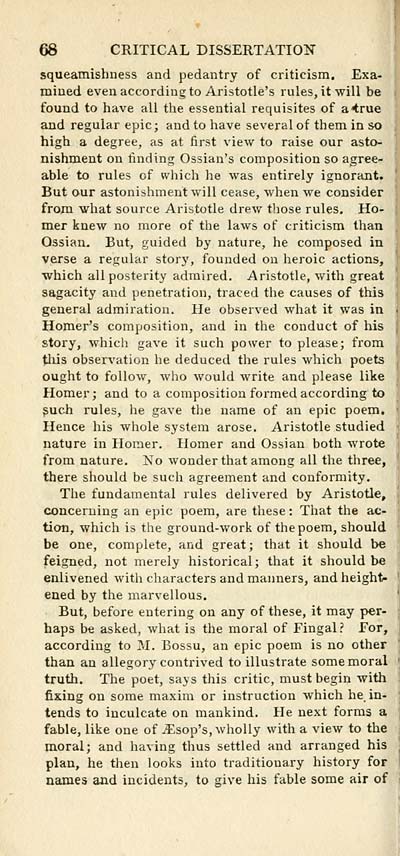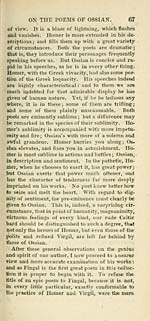Ossian Collection > Poems of Ossian
(116)
Download files
Complete book:
Individual page:
Thumbnail gallery: Grid view | List view

68 CRITICAL DISSERTATION
squeamishness and pedantry of criticism. Exa-
mined even according to Aristotle's rules, it will be
found to have all the essential requisites of a<rue
and regular epic ; and to have several of them in so
high a degree, as at first view to raise our asto-
nishment on finding Ossian's composition so agree-
able to rules of which lie was entirely ignorant.
But our astonishment will cease, when we consider
from -what source Aristotle drew those rules. Ho-
mer knew no more of the laws of criticism than
Ossian. But, guided by nature, he composed in
verse a regular story, founded on heroic actions,
which all posterity admired. Aristotle, with great
sagacity and penetration, traced the causes of this
general admiration. He observed what it was in
Homer's composition, and in the conduct of his
story, whicli gave it such power to please; from
tliis observation he deduced the rules which poets
ought to follow, who would write and please like
Homer; and to a composition formed according to
guch rules, he gave the name of an epic poem.
Hence his whole system arose. Aristotle studied
nature in Homer. Homer and Ossian both wrote
from nature. No wonder that among all the three,
there should be such agreement and conformity.
The fundamental rules delivered by Aristotle,
concerning an epic poem, are these : That the ac-
tion, which is the ground-work of the poem, should
be one, complete, and great; that it should be
feigned, not merely historical; that it should be
enlivened with characters and manners, and height-
ened by the marvellous.
But, before entering on any of these, it may per-
haps be asked, what is the moral of Fingal ? For,
according to M. Bossu, an epic poem is no other
than an allegory contrived to illustrate some moral ■
truth. The poet, says this critic, must begin with
fixing on some maxim or instruction which he. in-
tends to inculcate on mankind. He next forms a
fable, like one of .-Esop's, wholly with a view to the
moral; and liaving thus settled and arranged his .
plan, he then looks into traditionary history for ■
names and incidents, to give his fable some air of |
squeamishness and pedantry of criticism. Exa-
mined even according to Aristotle's rules, it will be
found to have all the essential requisites of a<rue
and regular epic ; and to have several of them in so
high a degree, as at first view to raise our asto-
nishment on finding Ossian's composition so agree-
able to rules of which lie was entirely ignorant.
But our astonishment will cease, when we consider
from -what source Aristotle drew those rules. Ho-
mer knew no more of the laws of criticism than
Ossian. But, guided by nature, he composed in
verse a regular story, founded on heroic actions,
which all posterity admired. Aristotle, with great
sagacity and penetration, traced the causes of this
general admiration. He observed what it was in
Homer's composition, and in the conduct of his
story, whicli gave it such power to please; from
tliis observation he deduced the rules which poets
ought to follow, who would write and please like
Homer; and to a composition formed according to
guch rules, he gave the name of an epic poem.
Hence his whole system arose. Aristotle studied
nature in Homer. Homer and Ossian both wrote
from nature. No wonder that among all the three,
there should be such agreement and conformity.
The fundamental rules delivered by Aristotle,
concerning an epic poem, are these : That the ac-
tion, which is the ground-work of the poem, should
be one, complete, and great; that it should be
feigned, not merely historical; that it should be
enlivened with characters and manners, and height-
ened by the marvellous.
But, before entering on any of these, it may per-
haps be asked, what is the moral of Fingal ? For,
according to M. Bossu, an epic poem is no other
than an allegory contrived to illustrate some moral ■
truth. The poet, says this critic, must begin with
fixing on some maxim or instruction which he. in-
tends to inculcate on mankind. He next forms a
fable, like one of .-Esop's, wholly with a view to the
moral; and liaving thus settled and arranged his .
plan, he then looks into traditionary history for ■
names and incidents, to give his fable some air of |
Set display mode to: Large image | Transcription
Images and transcriptions on this page, including medium image downloads, may be used under the Creative Commons Attribution 4.0 International Licence unless otherwise stated. ![]()
| Early Gaelic Book Collections > Ossian Collection > Poems of Ossian > (116) |
|---|
| Permanent URL | https://digital.nls.uk/77990229 |
|---|
| Description | Selected books from the Ossian Collection of 327 volumes, originally assembled by J. Norman Methven of Perth. Different editions and translations of James MacPherson's epic poem 'Ossian', some with a map of the 'Kingdom of Connor'. Also secondary material relating to Ossianic poetry and the Ossian controversy. |
|---|
| Description | Selected items from five 'Special and Named Printed Collections'. Includes books in Gaelic and other Celtic languages, works about the Gaels, their languages, literature, culture and history. |
|---|

